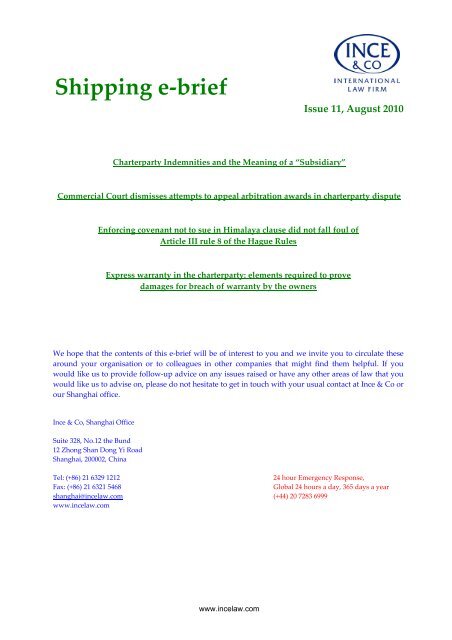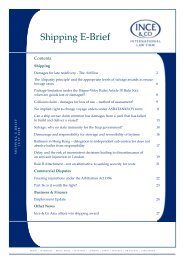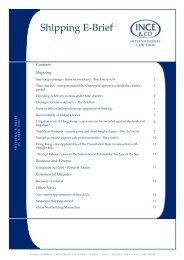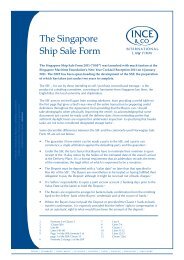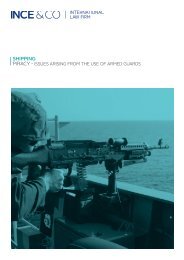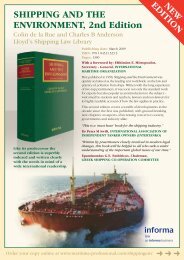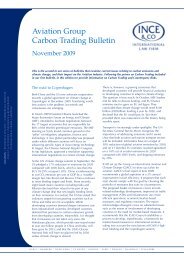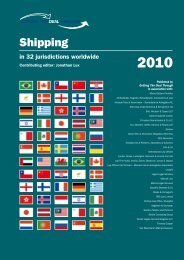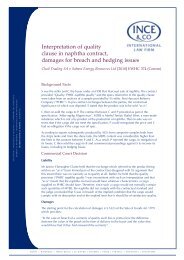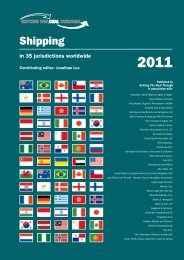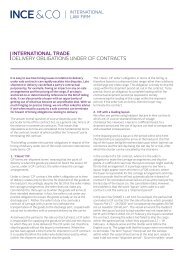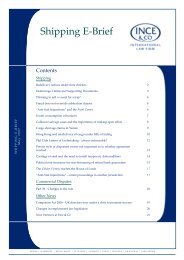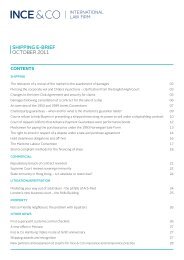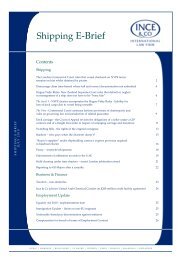Ince & Co Chinese Shipping E-brief August 2010 English Version
Ince & Co Chinese Shipping E-brief August 2010 English Version
Ince & Co Chinese Shipping E-brief August 2010 English Version
You also want an ePaper? Increase the reach of your titles
YUMPU automatically turns print PDFs into web optimized ePapers that Google loves.
<strong>Shipping</strong> e‐<strong>brief</strong>Issue 11, <strong>August</strong> <strong>2010</strong>Charterparty Indemnities and the Meaning of a “Subsidiary”<strong>Co</strong>mmercial <strong>Co</strong>urt dismisses attempts to appeal arbitration awards in charterparty disputeEnforcing covenant not to sue in Himalaya clause did not fall foul ofArticle III rule 8 of the Hague RulesExpress warranty in the charterparty: elements required to provedamages for breach of warranty by the ownersWe hope that the contents of this e‐<strong>brief</strong> will be of interest to you and we invite you to circulate thesearound your organisation or to colleagues in other companies that might find them helpful. If youwould like us to provide follow‐up advice on any issues raised or have any other areas of law that youwould like us to advise on, please do not hesitate to get in touch with your usual contact at <strong>Ince</strong> & <strong>Co</strong> orour Shanghai office.<strong>Ince</strong> & <strong>Co</strong>, Shanghai OfficeSuite 328, No.12 the Bund12 Zhong Shan Dong Yi RoadShanghai, 200002, ChinaTel: (+86) 21 6329 121224 hour Emergency Response,Fax: (+86) 21 6321 5468Global 24 hours a day, 365 days a yearshanghai@incelaw.com (+44) 20 7283 6999www.incelaw.comwww.incelaw.com
Charterparty Indemnities and theMeaning of a “Subsidiary”Enviroco Limited v Farstad Supply A/S (TheMV Far Service) [2009] EWCA Civ 1399In The MV Far Service, the <strong>Co</strong>urt of Appealconsidered the issue of whether a companywas an affiliated company for the purposesof an indemnity clause in a charterparty.The case turned on the definition of a“subsidiary” as found in the <strong>Co</strong>mpaniesAct, as incorporated into the charterparty.This case serves as a caution against theuse of boilerplate wording without givingdue consideration to the corporatestructures in place, although the particularissues in this case are unlikely to arise ingeneral circumstances.FactsIn 1997, Farstad Supply A/S (ʺOwnersʺ)chartered the oil rig supply vessel, MV FarService (ʺthe Vesselʺ) to Asco UK Limited(ʺCharterersʺ). In 2002, Enviroco Limited(ʺEnvirocoʺ), was appointed to clean thetanks of the Vessel prior to its sailing toone of BPʹs North Sea oil platforms.During the cleaning operation, oil whichwas being removed from the tanks cameinto contact with an ignition source andcaused a serious fire in the engine roomwhich killed one of Envirocoʹs employeesand caused substantial damage to theVessel. The Owners commencedproceedings in Scotland against Envirocofor damages for negligence. Envirocoadded the Charterers as a third party to theScottish proceedings, and then commencedproceedings in the High <strong>Co</strong>urt in Londonseeking a declaration that they wereentitled to benefit from an indemnityfound in the charterparty, which providedfor <strong>English</strong> law and jurisdiction.Clause 33 of the charterparty contained aseries of indemnities by Owners in favourof Charterers and their ʺaffiliatesʺ,including one in respect of all claims andliabilities resulting from loss and damageto the vessel, even if caused by negligence.The charterparty defined ʺAffiliateʺ asfollows:ʺʹAffiliateʹʺ means any subsidiary ofthe Charterer or Customer or acompany of which the Charterer orCustomer are a Subsidiary or acompany which is another Subsidiaryof a company of which the Charterer orCustomer is a Subsidiary. For thepurposes of this definitionʺSubsidiaryʺ shall have the meaningassigned to it in Section 736 of the<strong>Co</strong>mpanies Act 1985ʺ.Enviroco contended that it was an affiliateof the Charterers, and therefore entitled torely on the indemnities in the charterparty.In fact, Enviroco and the Charterers wereboth subsidiaries of a third company,ASCO plc. In 2005 however, ASCO plc hadcharged its shares in Enviroco under adeed of pledge to the Bank of Scotland assecurity, which required the shares to beregistered in the name of the bank or itsnominee. It was common ground that, butfor the existence of the pledge and theregistration of the bank as the holder of theshares, Enviroco and the Charterers wereboth “subsidiaries” of the same parentcompany and therefore “affiliates” asdefined in the charterparty.The question for the courts thereforeturned on the interpretation of thedefinition of “subsidiary” as found in s. 736of the <strong>Co</strong>mpanies Act 1985 [now s. 1159 ofthe <strong>Co</strong>mpanies Act 2006]. As a result of thebank becoming the registered owner of theshares, was Enviroco no longer a“subsidiary” of ASCO plc, and therefore not
entitled to benefit from the indemnityfound in the charterparty?The High <strong>Co</strong>urt DecisionThe High <strong>Co</strong>urt held that Enviroco was anaffiliate of the Charterers despite theexistence of the pledge, and therefore wasentitled to the benefit of the indemnity. Inessence, the High <strong>Co</strong>urt reasoned that sucha security arrangement would not preventASCO plc from continuing to act as aparent company.The <strong>Co</strong>urt of Appeal DecisionThe <strong>Co</strong>urt of Appeal allowed the appeal.Based on its interpretation of the applicableprovisions of the <strong>Co</strong>mpanies Act, which in<strong>brief</strong> provide that a company is a“subsidiary” of another company, if theholding or parent company is, inter alia, “amember of it”, the <strong>Co</strong>urt of Appeal foundthat Enviroco had in fact ceased to be asubsidiary of ASCO plc once the bankbecame the registered owner of the shares.The reasoning was based partly on s. 22 ofthe <strong>Co</strong>mpanies Act 1985 (which has beenmodified by s. 112(1) of the <strong>Co</strong>mpanies Act2006), which provides that to be a member,a person must have its name entered in theregister of members. The <strong>Co</strong>urt of Appealheld that as the statutory definitionrequired membership as a condition, if aparent is no longer a member then theunderlying company could not be its“subsidiary”. The <strong>Co</strong>urt of Appealrecognized that this interpretation mayproduce uncommercial results, however itstated that a court does not have the powerto revise the provisions of a statute simplyon these grounds.we understand the Supreme <strong>Co</strong>urt willhear the appeal in October of this year. Inthe meantime, although this case will onlyimpact on contractual provisions if (i) alender or its nominee has taken securityover the issued share capital of a companyand registered those shares in its name,and (ii) the contract incorporates thedefinition of “subsidiary” as found in the<strong>Co</strong>mpanies Act, it is nevertheless a cautionin respect of two matters. First, allowingthe registration of shares held by way ofsecurity, and secondly, ensuring thatcontractual provisions that refer toaffiliates or subsidiaries, such asindemnities, assignments, representations,and change of control provisions, aredrafted in a manner that accounts for theexisting corporate structure.nick.gould@incelaw.comvanessa.rochester@incelaw.com<strong>Co</strong>nclusionThe Supreme <strong>Co</strong>urt has granted leave toappeal the <strong>Co</strong>urt of Appeal’s decision and2
<strong>Co</strong>mmercial <strong>Co</strong>urt dismisses attempts toappeal arbitration awards in charterpartydisputeBuyuk Camlica <strong>Shipping</strong> Trading and Industry<strong>Co</strong> Inc v Progress Bulk Carriers Ltd (Hilal I)[<strong>2010</strong>] EWHC 442 (<strong>Co</strong>mm)In this charterparty dispute, the<strong>Co</strong>mmercial <strong>Co</strong>urt dealt with applicationsfor leave to appeal from two arbitrationawards under sections 68 and 69 of theArbitration Act 1996 (“the Act”). Itsconclusion, namely that there were nogood grounds for granting the applicationsunder either or both above‐mentionedsections, reflects the <strong>English</strong> courts’reluctance to interfere with the decisionsarrived at by commercial arbitrators unlessthose decisions are clearly unsustainable.The case also highlights the need forparties to properly develop and advancethe arguments on which they intend to relyand which they wish the arbitrators to dealwith expressly in their Award.Background factsThis litigation arose out of two separatetime charterparties for two consecutivecharter periods for the Hilal 1, both on anamended NYPE (1946) form (the “2004charterparty” and the “2005 charterparty”),the terms of which were substantially thesame. The dispute related primarily to theowners’ refusal to carry a cargo of HBI (hotmoulded briquettes of direct reduced iron)from Misurata in Libya under the 2004charterparty and a cargo of DRI (directreduced iron) from Trinidad to NewOrleans under the 2005 charterparty. Thecharterers alleged that they relied on thoseorally agreed variations to enter into twosub‐charterparties for the loading andcarriage of HBI and DRI out of the statedloadports, so that when the owners refusedto go to those ports to load those cargoes,the charterers suffered substantial loss anddamage.In LMAA arbitration proceedings, theTribunal issued two Awards but one set ofReasons covering the disputes under bothcharterparties. The arbitrators held asfollows:1. That both charterparties had beenorally varied by the parties, entitlingthe charterers to carry HBI and DRI,notwithstanding rider clause 38 ofeach of the charters which hadspecifically excluded from thecategories of permitted cargoes to beloaded any DRI cargoes in any form(this exclusion would have coveredthe HBI cargo also). Owners weretherefore in breach of charterpartycontracts in refusing to carry thesecargoes.2. That there had been a misdescriptionof the vessel in that the charterpartiesstated that the vessel’s mouldeddepth was 14.05 metres, whereas infact it was 16.1 metres. If the vessel’sactual moulded depth had compliedwith the charterparty description, herair draft would have come within theapplicable restrictions at both ports.In the event, however, the vesselwould not have been able to load theHBI and DRI because the vessel’sactual air draft exceeded the air draftrestrictions at the load ports by somemargin. There was therefore a breachof contractual warranty by theowners.3. That the two breaches, namelyrefusal to perform the voyage and themisdescriptionrenderingperformance physically impossible,when combined, entitled thecharterers to damages based on the3
difference between the notionalvoyage the vessel should haveperformed and the business she didinstead.Owners’ arguments on appealOwners did not seek to challenge thetribunal’s findings on the oral variations ofcharterparty agreements. However, theysought to appeal to the court on twogrounds. Firstly, they alleged that theTribunal was responsible for a seriousirregularity within the meaning of 68(2)(d)of the Arbitration Act 1996 (“the Act”) inthat it did not deal with all of the criticalissues put to it by the parties and that thishad caused the owners serious injusticebecause the charterers were not entitled tothe damages awarded to them even if therehad been a breach of oral agreement toload the HBI/DRI cargoes. In thealternative, they applied under section 69of the Act, arguing that the Tribunal haderred in law in awarding damages to thecharterers because there could be noactionable breach as the vessel could notphysically or safely have loaded at eitherload port. Given that the owners’applications for leave to appeal had beenmade out of time, they also soughtextensions of time to make theirapplications.<strong>Co</strong>mmercial <strong>Co</strong>urt decisionIn dealing with the application undersection 68(2)(d), the judge considered thatthe primary issue which might arguablynot have been dealt with by the Tribunalwas the question of whether the charterershad waived the breach of the descriptionwarranties by reason of their being inpossession of information concerning thereal moulded depth and/or havingreceived air draft calculations from themaster which demonstrated that the vesselwould not be able to load at eitherloadport. There was no mention of thisissue in either the Award or the Reasons.Whilst the judge said that it was sufficientto show that if the issue had been dealtwith, the Tribunal might have reached adifferent view in favour of the applicant(ABB AG v Hochtief Airport GmbH [2006] 2Lloyd’s Rep 1), in this case he did notconsider it to be reasonably arguable thatthe charterers waived the breach of thedescription warranties in thecharterparties. Quite apart from the factthat the waiver defence had only beenmade in owners’ closing submissions in thearbitration but never properly explained ordeveloped, the judge said that thepossession of information as to the realmoulded depth and the air draftcalculations was in and of itself inadequateand insufficient to make it arguable thatthe charterers had unequivocallyrepresented to the owners that they wouldnot rely on the charterparty description ofthe vessel and would not insist on theirstrict legal rights to claim damages formisdescription. <strong>Co</strong>nsequently, the judgefound that even if there had been anirregularity, it was not a seriousirregularity within the meaning of section68(2)(d).Turning to the application under section69, the judge considered the owners’argument that there can have been nobreach to load the HBI/DRI cargoes if itwas unsafe or impossible to do so andconsequently in breach of the safeberth/port warranties in the charterparties.The judge disagreed and said that theowners agreed to load those cargoes onboard a vessel that was warranted to havethe described characteristics as set out inthe charterparties. If the vessel had been aswarranted, there could be no basis onwhich the owners could have contended4
(after the event) that the charterers couldnot recover damages because the vesselcould not physically or safely have loadedthose cargoes. Under each charterparty, asvaried, there was both a breach ofagreement and a breach of warranty and itwas perfectly understandable, in thejudge’s opinion, why in thosecircumstances the Tribunal concluded thatthe combination of those breaches entitledthe charterers to recover damages of thenature claimed. The Tribunal’s decisionwas not therefore obviously wrong.Therefore, the judge refused the owners’applications for extensions of time tochallenge the Awards under both sections68 and 69 and also stated that hadextensions of time been granted, he wouldhave rejected the applications to challengethe Awards under either or both sections.jonathan.elvey@incelaw.comreema.shour@incelaw.comEnforcing covenant not to sue inHimalaya clause did not fall foul ofArticle III rule 8 of the Hague RulesWhitesea <strong>Shipping</strong> and Trading <strong>Co</strong>rporation& Anr v El Paso Rio Clara LTDA & Ors (TheMarielle Bolten) [2009] EWHC 2552 (<strong>Co</strong>mm)In October 2009, <strong>Ince</strong> & <strong>Co</strong> successfullyobtained an interim anti‐suit injunction onbehalf of Whitesea <strong>Shipping</strong> (Owners),restraining cargo interests and theirinsurers from suing third parties to thebills of lading outside of the <strong>English</strong> courts,in breach of the covenant not to sue thirdparties and the exclusive <strong>English</strong> law andjurisdiction clause in the bills.Brief FactsThe Marielle Bolten grounded off PuertoPlata, Dominican Republic in January 2006,laden with cargo carried under a numberof bills of lading. General average wasdeclared and cargo interests put upaverage bonds and guarantees. The GAadjustment was published in June 2009,following which Owners sought to recoverGA contributions from cargo interests.However, prior to the publication of theadjustment, cargo interests under anumber of bills of lading commencedproceedings against Owners in Brazil(most notably), claiming damages on anumber of different grounds. Theseactions were in breach of exclusive <strong>English</strong>law and jurisdiction clauses contained inthe bills of lading, average bonds andaverage guarantees.Cargo interests admitted that theyintended to circumvent the Hague Rules(which applied to the bills on account of aclause paramount), in circumstances whereOwners argued that they were entitled torecover GA contributions because the5
grounding was caused by negligentnavigation and/or perils of the sea whichgave rise to defences under the HagueRules. As the Hague Rules do not apply inBrazil, the Hague Rules defences wouldnot be available to Owners before theBrazilian court.Mr Justice Flaux had little difficulty infinding that Owners were entitled to ananti‐suit injunction to prevent cargointerests from suing them abroad. Themore difficult question, and the one whichthis judgment addresses, is whether cargointerests could also be injuncted fromsuing third parties outside of England.This question arose because the Brazilianaction was also filed against Owners’managers, P&I insurers, charterers andsub‐charterers.Owners’ Case for an InjunctionIn asking the High <strong>Co</strong>urt to grant an antisuitinjunction restraining proceedingsagainst third parties, Owners relied onclause 3(b) of the bill of lading whichstated:1. that the merchant undertook not tobring any claims against anyservant, agent, stevedore orsubcontractor of the carrier (thecovenant not to sue);2. if it did, the merchant furtherundertook to indemnify the carrieragainst all consequences (thecircular indemnity clause); and3. that every servant, agent, stevedoreor subcontractor of the carriernevertheless had the benefit of allthe provisions in the bills benefitingthe carrier, including all limitationsof and exonerations from liabilityprovided to the carrier by law (theHimalaya clause).Owners argued that the third parties suedin Brazil were all either Owners’ servants,agents or sub‐contractors (within thedefinition in the bills of lading) and thatthe Cargo interests were bound by theircovenant not to sue, and Owners wereentitled to an injunction to enforce thecovenant.The Defence based on Art III r 8 and the<strong>Co</strong>urt’s DecisionThe Cargo interests contended that thecovenant not to sue in clause 3(b) was nulland void because it amounted toconferring on the third parties a blanketimmunity from liability, which would becontrary to Art. III r. 8 of the Hague Rules.Art. III r. 8 states:“Any clause, covenant or agreement in acontract of carriage relieving the carrier or theship from liability for loss or damage to or inconnection with the goods, arising fromnegligence, fault, or failure in the duties andobligations provided in this section, orlessening such liability otherwise than asprovided in this chapter, shall be null and voidand of no effect.”The Cargo interests argued that thecovenant not to sue, as it appeared in thebills, was enforceable not just by thecontractual carrier, but also by those thirdparties who were protected by clause 3(b)under the so‐called “Himalaya contract”.However, as soon as a third partyperformed “carriage” obligations, theHimalaya contract itself became a contractof carriage to which the Hague Rules,including Article III r.8, applied. The judgedisagreed. He carefully considered thedecision of Lord Justice Rix in the <strong>Co</strong>urt ofAppeal in The Starsin, and applied his6
easoning that a similarly wordedcovenant not to sue was only enforceableby the contractual carrier to prevent theshipper from suing third parties. The thirdparty was only intended to have thebenefit of such defences and immunities aswere available to the carrier to defend itselffrom incurring liability.The Cargo interests further argued thateven if the covenant not to sue could onlybe enforced on behalf of a third party, if athird party had performed “carriage”obligations, any attempt to grant that thirdparty total protection from being suedcontravened Art. III r.8, again because theHimalaya contract itself became a contractof carriage to which the Hague Rulesapplied. The Cargo interests said that thisargument was supported by the decisionon this point of the House of Lords in TheStarsin. Again, the judge disagreed. Afteranalysing each of the five judgments givenby the Lords in The Starsin, Mr JusticeFlaux held that the real reason the <strong>Co</strong>urt inthat case found that the Himalaya contractwas a contract of carriage was not becausethe third party had performed “carriagefunctions”, but because the Himalayaclause in the particular bill of ladingincluded a “deeming” provision. This saidthat to the extent that parties wereprotected by the Himalaya clause, theyshould be deemed to be parties to the billof lading contract. There was no suchdeeming provision in the bill of ladingissued for cargo shipped onboard theMarielle Bolten.functions which the relevant third partieswere in fact performing, he was firmly ofthe view that although the managers, P&Iinsurers, charterers and sub charterers allperformed services incidental to thecarriage of goods, none of them hadactually undertaken the carriage of thegoods.Furthermore, the judge was persuaded thaton the facts, by commencing proceedingsin Brazil, in breach of the exclusive <strong>English</strong><strong>Co</strong>urt jurisdiction clause, it was the Cargointerests, and not Owners, who wereseeking to circumvent the application ofthe Hague Rules.<strong>Co</strong>nsequently, the anti‐suit injunction,restraining proceedings from beingcommenced or continued against the thirdparties was granted.michael.volikas@incelaw.comcarrie.angell@incelaw.comFinally, the Cargo interests submitted thateven if both of the previous propositionswere wrong, the contractual carrier shouldnot be allowed to enforce the covenant notto sue because this would have the effect ofcircumventing Art. III r.8. The judge heldthat there was no authority in support ofthis submission. Having considered the7
Express warranty in the charterparty:elements required to prove damages forbreach of warranty by the ownersAl Dawood <strong>Shipping</strong> Lines Limited v DynasticMaritime Incorporated (MT Napa) [<strong>2010</strong>]EWCA Civ 104This decision of the <strong>Co</strong>urt of Appealhighlights the elements of claim thatcharterers need to prove in order tosucceed in an action against owners forbreach of express warranty by the owners.Faced with the owners’ claim for unpaidhire and damages, the charterers putforward the defence of breach of warrantyand counterclaimed for the loss of profitthat they would have made on the subcharterhad the owners complied with thewarranty. To succeed, charterers needed todemonstrate that the owners breached thewarranty, that they would have been ableto have concluded the sub‐charter but forthe breach and that the hire rate of suchsub‐charter would have been higher thanthe charter hire rate.The case is also an important illustration ofthe fact that a party who fails to complywith procedural deadlines and courtorders risks losing an opportunity to putforward its case.FactsThe MT Napa charterparty was for a periodfrom November 2006 to November 2007 onBPTime 3 form. The original cancellingdate of 30 November 2006 was lateramended to 8 December 2006.The Charterparty stated that it included“…OCIMF Vessel Particulars Questionnaireor Q88 current at the date hereof (togetherreferred to as the “Questionnaire”) as attachedhereto.”Clause 9.6.5 of the charterparty expresslyprovided that the certificates confirmed bythe owners “shall be maintained in forceduring the currency of the Charter.” The Q88was attached to the charterparty andincluded the International Oil PollutionPrevention Certificate (“IOPP Certificate”)in the list of certificates confirmed by theowners. The Q88 also contained a referenceto paragraph 2.6 of the OCIMF RevisedShip Inspection (SIRE) Programme form(the “SIRE form”). The standard SIRE formwas completed for MT Napa and containedparagraph 2.6 which stated that the IOPPCertificate was issued on 20 November2006 and that it expired on 20 November2009. The <strong>Co</strong>urt found that the SIRE formwas most likely completed after thecharterparty was signed.On 6 December 2006, the owners producedthe IOPP certificate, which was called an“Interim Certificate” and which was validuntil 15 May 2007. Prior to the certificatebeing provided, in November 2006, thecharterers chased the brokers for thecertificate and told them that the potentialsub‐charterer was awaiting it prior tomaking a decision whether or not to subcharterthe vessel.The vessel was delivered on 8 December2006. The first instalment of hire was notreceived by the owners and the vessel waswithdrawn shortly afterwards.Procedural HistoryThe owners commenced an action for hiredue, the cost of bunkers and damages forwrongful repudiation.The charterers’ main defence was that theowners breached an express warranty thatthe vessel’s IOPP Certificate would beissued on 20 November 2006 for a period8
of validity of three years until 20November 2009 and that as a result of suchbreach, the charterers were unable to subcharterthe vessel, which led to theirinability to pay the hire. In effect, thecharterers alleged that any failure to payhire by them was the result of the owners’own breach of the charter.The charterers also counterclaimeddamages arising from their inability tosecure a sub‐charter due to the owners’failure to provide an IOPP Certificate inaccordance with the charterparty.Following the exchange of pleadingsbetween the parties, the charterers took nofurther part in the proceedings. Thisultimately resulted in a court orderdismissing their counterclaim andultimately in judgment being entered infavour of the owners for the sum of US$3,034,970.75 plus interest.This judgment prompted the charterersinto action and they applied to set aside thecourt order dismissing their counterclaimand for setting aside the judgment enteredagainst them. Mr Justice <strong>Co</strong>okecommented that the charterers brought thissituation on their own heads by their ownactions and that they were “reckless inallowing judgment to be entered against them.”Whilst he refused to set aside the orderdismissing the counterclaim on the basisthat it had no prospect of success, heagreed to set aside the judgment enteredagainst the charterers on condition thatpart of the claim relating to unpaid hire(about US$136,000), costs to date andfuture costs of the action be paid by thecharterers. The charterers failed to complywith these conditions, but applied for andobtained permission to appeal the decisionof Mr Justice <strong>Co</strong>oke setting aside theircounterclaim and laying down conditionsfor setting aside the judgment.The <strong>Co</strong>urt of Appeal decisionIn the <strong>Co</strong>urt of Appeal, the charterers hadto persuade the <strong>Co</strong>urt that they had areasonable prospect of success indemonstrating their entitlement todamages arising from the alleged breachby the owners of the express warranty toprovide a valid IOPP certificate. Thecharterers accepted that the correctmeasure of damages for such a claimwould be the loss of profit that they wouldhave made if they had been able to subcharterthe vessel.The <strong>Co</strong>urt of Appeal found that the SIREform was not incorporated into thecharterparty by mere reference toparagraph 2.6 in Q88. That was found to bea reference to a standard SIRE form andnot the form as completed for thisparticular vessel. Therefore, the owners didnot warrant that there would be a singleIOPP Certificate valid for 3 years from 20November 2006 to 20 November 2009.The only warranty given by the ownerswas a clause in the charterparty that statedthat certificates confirmed by the owners inQ88 “shall be maintained in force during thecurrency of the Charter.” The “currency of thecharterparty” means the time from deliveryof the vessel under the charter until itsexpiry. The above wording of the clausedoes not require a valid IOPP certificate inadvance of delivery of the vessel or thatthere must be one single IOPP certificatethat is valid from start to finish of thecharter period as long as the ownersmaintain the certificate in force throughoutthe charter period.The <strong>Co</strong>urt of Appeal proceeded to statethat even if there was such a warranty asalleged by the charterers and the ownersbreached it, then the charterers still failedto prove that this breach meant that they9
were unable to conclude a sub‐charter forthe vessel for this very reason. Inparticular, there was no recap exchangedbetween charterers and potential subcharterersindicating that agreement wasreached between them and was subject tosatisfactory production of the vessel’s IOPPcertificate.Furthermore, the <strong>Co</strong>urt of Appeal foundthat even if the charterers coulddemonstrate that sub‐charterers wouldhave sub‐chartered the vessel, they stillfailed to demonstrate that the failure tosub‐charter the vessel resulted in a loss, i.e.that the sub‐charter rate of hire would havebeen higher than the charter rate of hire.In light of this, the <strong>Co</strong>urt of Appealconfirmed that Mr Justice <strong>Co</strong>oke was rightto conclude that the charterers’counterclaim had no prospect of success.The <strong>Co</strong>urt of Appeal also held that thejudge had been correct in setting downconditions that charterers had to complywith before being able to argue theirdefences. The appeal was thereforedismissed.graham.crane@incelaw.comanna.fomina@incelaw.com10


